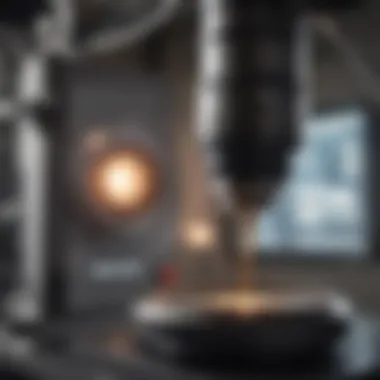Exploring Environmental Scanning Electron Microscopes


Intro
Environmental Scanning Electron Microscopes (ESEM) have emerged as a pivotal tool in the field of microscopy. ESEM technology not only allows scientists to view specimens with high resolution but also does so under variable environmental conditions. This capability addresses a significant limitation of traditional Scanning Electron Microscopes (SEM), which typically require samples to be coated with conductive materials, potentially altering their natural state. ESEM provides the means to explore materials and biological specimens in a more authentic form, which is crucial for advancements in various scientific disciplines.
Overview of Research Topic
Brief Background and Context
The development of ESEM can be traced back to the need for advanced imaging techniques that accommodate the study of specimens in their natural environments. Traditional SEM has been invaluable in materials science and biology but has its drawbacks. The introduction of ESEM technology represents a significant shift in this paradigm, enabling researchers to observe live specimens without the constraints imposed by vacuum conditions.
Importance in Current Scientific Landscape
ESEM plays a critical role in numerous fields. In materials science, it assists with the investigation of surface properties and morphology of diverse materials. In biology, ESEM is indispensable for examining cell structures and interactions in situ. The capability to analyze materials at the nanoscale has heightened its significance in nanotechnology. As research becomes increasingly interdisciplinary, ESEM offers vital contributions across various domains, enhancing our understanding of material behaviors, biological interactions, and complex systems.
Methodology
Research Design and Approach
A systematic approach is essential for studying ESEM. The research typically involves both theoretical and practical components, encompassing literature review and hands-on experimentation. This blend allows for a comprehensive understanding of ESEM technology and its application potential.
Data Collection Techniques
Data collection often employs several techniques:
- Imaging: Various imaging modes are utilized to capture detailed views of samples under different environmental conditions.
- Spectroscopy: ESEM frequently collaborates with energy-dispersive spectroscopy to analyze elemental composition.
- Environmental Control: It monitors and adjusts environmental parameters such as gas composition and pressure during observations.
The integration of these techniques enhances the quality of data obtained and provides insights into the behavior of materials and biological specimens under observation.
Prelims to Environmental Scanning Electron Microscopes
Environmental Scanning Electron Microscopes (ESEM) represent a pivotal advancement in imaging technology. This section delves into the foundational knowledge necessary to appreciate the intricate functionalities of ESEM. Understanding ESEM is critical due to its ability to observe samples in their natural, hydrated state, a feat not achievable by traditional SEM. This capability opens doors to countless applications across various scientific fields.
Such understanding is significant for students, researchers, educators, and professionals. It presents avenues for more accurate data interpretation, enabling advancements in biological research, materials science, and nanotechnology. Not only does ESEM provide detailed insights into specimen morphology, but it also captures dynamic processes in real-time, thereby enhancing the quality of scientific inquiry.
Definition and Overview of ESEM
ESEM is a type of electron microscope that allows for imaging and analysis of specimens in a controlled gaseous environment. Unlike conventional scanning electron microscopes that require samples to be desiccated, ESEM can analyze wet or volatile specimens. This feature is achieved by modifying the usual vacuum environment, replacing it with a lower pressure suitable for capturing high-quality images while maintaining natural conditions. The ESEM uses an electron beam to produce images by scattering electrons from the surface of the specimen, which are then collected to form detailed images.
Historical Development of ESEM Technology
ESEM technology originated in the late 1980s and gained traction through the 1990s. The initial idea targeted a limitation inherent in traditional SEM regarding sample dehydration. Researchers sought a solution that would facilitate more versatile analyses. The breakthrough in ESEM came from advancements in gas injection systems and improved electron detectors. As interest in real-time observation grew within various scientific fields, so did the development of ESEM, making it a viable alternative for many who depended on electron microscopy.
Comparison with Traditional Scanning Electron Microscopes
The comparison between ESEM and traditional SEM is crucial for understanding their respective advantages and limitations. Traditional scanning electron microscopes operate under high vacuum conditions, requiring samples to be dry and free from moisture. This often leads to artifacts in the images and limits the types of samples that can be analyzed. ESEM, however, allows users to observe specimens in their natural state, using a gas environment to prevent charging and dehydration.


Another key distinction involves the operational flexibility of ESEM. Because it can handle a broader range of sample types—such as biological materials or materials containing volatile compounds—it fosters a more inclusive scientific exploration. From another lens, the technical specifications of ESEM could involve higher operational costs and require more complex maintenance than traditional SEM, presenting potential challenges for some research facilities.
"ESEM technology represents a significant leap forward, allowing researchers to explore a broader array of specimens without the constraints imposed by conventional electron microscopy."
Overall, understanding these comparisons allows all stakeholders in scientific research to better select imaging techniques suitable for their specific applications.
Technical Principles of ESEM
The Technical Principles of Environmental Scanning Electron Microscopes (ESEM) are fundamental in understanding how this technology operates and what advantages it brings to the scientific community. ESEM provides advantageous methods over traditional electron microscopy, particularly in situations where maintaining specimen integrity and natural environment is crucial. This section will discuss the operational mechanisms, construction features, and imaging techniques of ESEM.
Operational Mechanism of ESEM
The operational mechanism of ESEM is distinct from traditional scanning electron microscopes. ESEM utilizes a special gas environment, allowing specimens to be imaged in their natural state without needing elaborate sample preparation. In ESEM, a low-pressure environment is created around the sample, which retains moisture and allows for the observation of biological and other sensitive materials without dehydration. This versatility is essential for many applications in biological research and materials science.
Unlike traditional SEM, where the vacuum level is higher, ESEM operates at a partial pressure of water vapor. This enables the detection of secondary electrons while simultaneously providing a more realistic representation of the specimen. Moreover, it allows the imaging of wet samples, crucial for various biological processes. These mechanisms ensure that the imaging does not alter the physicality and behavior of sensitive specimens.
Construction and Components of ESEM
The construction of an ESEM comprises several key components, each tailored to enhance its operational capacity. The primary elements include:
- Electron Source: Typically, a field emission gun is used, offering a focused and stable electron beam.
- Electron Optics: This part controls the beam's path, allowing for precise focusing and steering towards the sample.
- Specimen Chamber: The ESEM features a unique chamber that maintains a controlled environment. Here, samples can retain moisture, and environmental conditions can be adjusted as needed.
- Detector System: Specialized detectors capture secondary electrons and other emissions from the sample, which aids in creating a comprehensive image of the specimen.
- Pressure Control System: This system enables adjustments to the gas environment surrounding the sample, crucial for effective imaging under various conditions.
The thoughtful construction of ESEM permits its diverse functionality, extending its application across various fields.
Imaging Techniques in ESEM
Imaging techniques employed in ESEM are diverse and cater to specific research needs. The primary methods include:
- Secondary Electron Imaging (SEI): This technique is the most common, providing high-resolution images by detecting secondary electrons emitted by the sample's surface. It is effective for topographic studies and surface morphology.
- Backscattered Electron Imaging (BEI): This method utilizes higher energy electrons to produce images based on atomic number contrast, allowing for the differentiation of composition within samples.
- X-Ray Microanalysis: ESEM can also conduct elemental analyses directly from SEM images, allowing researchers to gather information about the sample’s composition without moving it to another device.
- Environmental Imaging: This innovative approach allows observation under various environmental conditions. With ESEM, researchers can monitor live biological processes or sample responses to different environments, which is not feasible with traditional methods.
ESEM's ability to operate under variable environmental conditions sets it apart from conventional SEM, making it a vital tool in modern scientific research.
Understanding these imaging techniques is crucial for researchers aiming to employ ESEM effectively in their studies. Each method serves specific functions and can yield data that informs on a specimen's structure, composition, and behavior in real-time.
Key Features and Advantages of ESEM
The ability to analyze specimens effectively gives Environmental Scanning Electron Microscopes a unique position in scientific research. Understanding the key features and advantages of ESEM technology allows researchers to leverage its full potential in varied disciplines. This section will cover several important aspects:
- Ability to analyze specimens in natural environments.
- Enhanced depth of field and resolution.
- Versatility in sample handling.
Ability to Analyze Specimens in Natural Environments
One of the most significant advantages of ESEM is its capability to observe samples in natural environments. Traditional scanning electron microscopes (SEM) typically require a vacuum chamber to operate. In contrast, ESEM can work under different gas pressures, enabling the examination of wet or volatile samples without altering their state. Such capabilities are crucial in biological and material sciences, where the structure and integrity of a sample can be compromised by the harsh conditions of traditional microscopy.
For instance, when looking at biological tissues, studying them in physiological conditions is essential for understanding their real-life interactions. This ability enhances the accuracy of observations and results, providing a clearer picture of the specimen's characteristics. Researchers thus can obtain data that reflects more realistic biological and physical behaviors.
Enhanced Depth of Field and Resolution


ESEM provides superior depth of field compared to traditional SEM. Depth of field refers to the range of distance within which objects appear in focus. Enhanced depth of field is crucial when studying complex structures with varying elevations. With ESEM, researchers can obtain sharper and more comprehensive images without extensive recalibration or adjustments to focus. This feature is particularly valuable in nanoscale investigations, where precision is key.
Moreover, ESEM often achieves high resolution while imaging specimens. The technology utilizes a focused electron beam, which results in detailed images of sample surfaces. It enables scientists to analyze materials at nanometer scales, making it beneficial in fields such as nanotechnology and materials science.
Versatility in Sample Handling
ESEM is notably versatile in terms of sample handling. It accommodates a wide array of samples, from biological tissues to manufactured materials and even geological specimens. With proper adjustments, ESEM can analyze fragile or irregularly shaped samples that might not be compatible with conventional scanning electron microscopy.
The adaptability of ESEM allows researchers to explore different types of samples, promoting a broader spectrum of scientific inquiry. This versatility makes it an invaluable tool across various scientific domains, including biological research, materials science, and environmental studies. The range of materials and conditions ESEM can handle emphasizes its importance in today’s multi-disciplinary research environments.
"ESEM represents a leap forward in microscopy, providing researchers with opportunities to study specimens without distorting their natural state, thus enhancing the depth and relevance of their findings."
Limitations and Challenges in ESEM
The discussion of environmental scanning electron microscopes (ESEM) cannot overlook the limitations and challenges that accompany this technology. While ESEM offers unique advantages, such as the ability to analyze samples in their natural environment, certain constraints can impact its effectiveness. Understanding these limitations not only informs the choice to use ESEM but also aids in the interpretation of results. Here we will explore several key challenges associated with ESEM technology.
Sample Preparation Constraints
Sample preparation is critical in any microscopy technique, and ESEM is no exception. Unlike traditional scanning electron microscopes, which often require samples to be coated with conductive materials, ESEM allows for observations in a more natural state. However, this does not eliminate the need for careful sample handling.
Certain types of specimens can be very delicate and may require specific treatment before they can be placed in the ESEM chamber. Biological samples, for instance, can deteriorate under vacuum conditions or high electron beam energies. Meanwhile, samples that emit gas during observation pose additional risks, as they might interfere with the imaging process or damage the microscope.
Thus, while ESEM reduces some of the restraints of sample preparation, it still necessitates skilled techniques and an understanding of how the sample will behave in an ESEM environment.
Operational Costs and Accessibility
The operational costs associated with ESEM can present challenges for laboratories, especially those operating within budget constraints. The investment in ESEM equipment itself is often substantial. Additionally, the maintenance and operational expenses can accumulate over time.
Training personnel to use ESEM effectively is another cost factor. Users must not only understand the technical aspects of the equipment but also develop competencies related to specimen handling and data interpretation.
Moreover, ESEM technology is not universally accessible. Facilities might remain limited to well-funded research institutions and universities, creating disparities in research capabilities between different organizations. This limited accessibility can stifle innovation within various fields.
Data Interpretation Difficulties
Despite the benefits of ESEM for imaging complex samples, interpreting the data generated can present significant challenges. The resultant images can be affected by various environmental conditions within the microscope, affecting clarity and resolution.
One primary difficulty relates to understanding the differences in contrast for materials with similar atomic numbers. This can lead to misinterpretation, potentially skewing research outcomes. Additionally, the presence of gaseous environments, a key feature of ESEM, may introduce complexities that complicate analysis.
Researchers must be aware of these factors and develop robust methods for data analysis. Expertise in both microscopy and the specific subject matter is crucial in ensuring accurate interpretation of findings.
The limitations described highlight the importance of meticulous planning and understanding when utilizing ESEM technology. By recognizing these challenges, researchers can better prepare and apply ESEM techniques in their work.
Applications of ESEM in Various Scientific Fields
The applications of Environmental Scanning Electron Microscopes (ESEM) span a vast range of scientific disciplines. This section emphasizes the significance of ESEM technology as a versatile tool, facilitating advanced analysis and research. Not only does ESEM enhance our ability to observe intricate details, it also allows scientists to examine samples in conditions closer to their natural environment. This capability proves crucial for drawing accurate conclusions across different fields.


One of the most vital aspects of ESEM is its role in biological research and cell imaging. Here, researchers can visualize living cells without extensive sample preparation. By maintaining relevant pressure and humidity, the ESEM preserves biological specimens in their native states. The implications for medicine and cellular biology are profound, paving the way for improved diagnostic tools and therapeutic options.
Another noteworthy application resides in materials science and nanotechnology. ESEM provides insights into the structural properties of materials at the nanoscale. The ability to analyze materials under various environmental conditions means researchers can study how different factors impact material performance. This understanding is essential for developing new materials and applications in industries ranging from electronics to renewable energy.
Additionally, ESEM finds its relevance in geological and environmental studies. When examining minerals, soils, and sediments, the ability to understand sample morphology under variable conditions offers crucial data for environmental assessments and resource management. Thus, ESEM serves as a key instrument for geologists and environmental scientists looking to analyze samples with precision and depth.
In summary, the applications of ESEM across biological, materials, and geological studies significantly enhance our understanding of complex systems. By facilitating real-world analysis, ESEM strengthens scientific inquiry and innovations across disciplines.
Future Prospects of ESEM Technology
The future of Environmental Scanning Electron Microscopes (ESEM) is marked by potential advancements that can expand its capabilities and applications. As research continues to evolve, the integration of ESEM technology is expected to present significant benefits across various scientific domains. Understanding these prospects is crucial for both researchers and institutions aiming to remain at the forefront of microscopy technology.
Advancements in Detector Technologies
Recent advancements in detector technology hold promise for improving the performance of ESEM. One area of focus is the development of specialized detectors that can enhance detection sensitivity and increase the speed of image acquisition. New materials, such as silicon-based detectors, are being researched to provide better resolution under different environmental conditions.
Additionally, digital imaging systems are evolving to allow real-time data collection. This capability can significantly improve sample analysis in various fields, from material sciences to life sciences. The refinement of electron detectors could lead to increased depth resolution and improved quantification of elemental composition, which is valuable in intricate analyses of nanostructures.
Integration with Other Analytical Techniques
Another important factor in the future of ESEM is its potential for integration with other analytical techniques. Combining ESEM with techniques, such as X-ray diffraction, energy-dispersive X-ray spectroscopy, and atomic force microscopy, can yield comprehensive data on the sample being studied.
For example, using ESEM alongside X-ray diffraction enables researchers to study not just the surface topography but also the material properties at a structural level. This multidimensional approach can lead to deeper insights, especially in multidisciplinary areas of research like nanotechnology and biomaterials. The ability to cocombine various analytical methods under the same experimental conditions addresses many limitations inherent in traditional microscopy approaches.
Potential Developments in User Accessibility
User accessibility remains a key concern as technology advances. Enhancing accessibility to ESEM systems can encourage more widespread use, making these sophisticated tools available to a broader audience.
Future developments may focus on simplifying the operation of ESEM. This could involve user-friendly software designed for non-specialists, making it feasible for researchers without extensive training to effectively utilize ESEM systems. Ensuring that these tools are not only powerful but also intuitive will likely promote their integration into educational settings as well as industry applications. This democratization of technology could lead to increased innovation as more users engage with ESEM's capabilities.
"The continuous development of ESEM technology signifies a shift towards more accessible and versatile tools, essential for advancing scientific exploration across disciplines."
The future prospects of ESEM technology are expected to bring a cascade of enhancements, making it a central tool in many research endeavors. Through better detectors, integration capabilities, and improved accessibility, ESEM can redefine how specimens are analyzed in their natural environments.
Ending
The conclusion serves as a pivotal section in this article, encapsulating the essence of Environmental Scanning Electron Microscopes (ESEM) and its overarching significance in scientific research. By summarizing the various capabilities and applications of ESEM, it reinforces the concept that this technology is not merely an advanced microscopy tool, but a vital instrument that provides unparalleled insights into the behavior and characteristics of materials and biological specimens under realistic conditions.
Summary of ESEM Capabilities
ESEM is distinct due to its ability to analyze samples in their natural state without the need for extensive preparation or coating. This capability leads to several key advantages:
- Natural Environment Analysis: ESEM can observe specimens in a controlled gas environment, allowing scientists to study them under conditions they would experience in their natural habitats. This is particularly relevant in biological studies and materials science.
- Enhanced Imaging: With improved depth of field and magnification, ESEM provides high-resolution images that are accurate to the material structure, offering clearer insights than traditional methods.
- Versatile Sample Handling: ESEM can accommodate a wide range of sample types, from wet biological samples to dry, granular materials. This versatility enhances its application across multiple scientific domains.
These capabilities underscore ESEM's importance, enabling researchers to obtain meaningful data that would be challenging or impossible with other techniques.
Implications for Future Research
Looking forward, the implications of ESEM in future research are vast and promising. The advancements in detector technologies, as well as the integration of ESEM with other analytical methods, will expand its utility even further. These developments may include:
- Improved Sensitivity: Enhanced detectors will increase the effectiveness of ESEM in analyzing extremely small structures at atomic levels.
- Multimodal Analysis: Combining ESEM with techniques like X-ray diffraction or transmission electron microscopy may provide comprehensive data about material properties and behaviors.
- Wider Accessibility: As ESEM technology progresses, the potential for reduced costs and improved ease of use can democratize access to advanced microscopy methods, enabling more researchers to utilize this technology in their work.
In summary, as ESEM evolves, it will continue to shape research methodologies and open new frontiers across various disciplines, influencing how scientific discovery unfolds in the coming years. The relevance of ESEM in diverse scientific fields assures that it will remain a cornerstone for future exploration and innovation.



